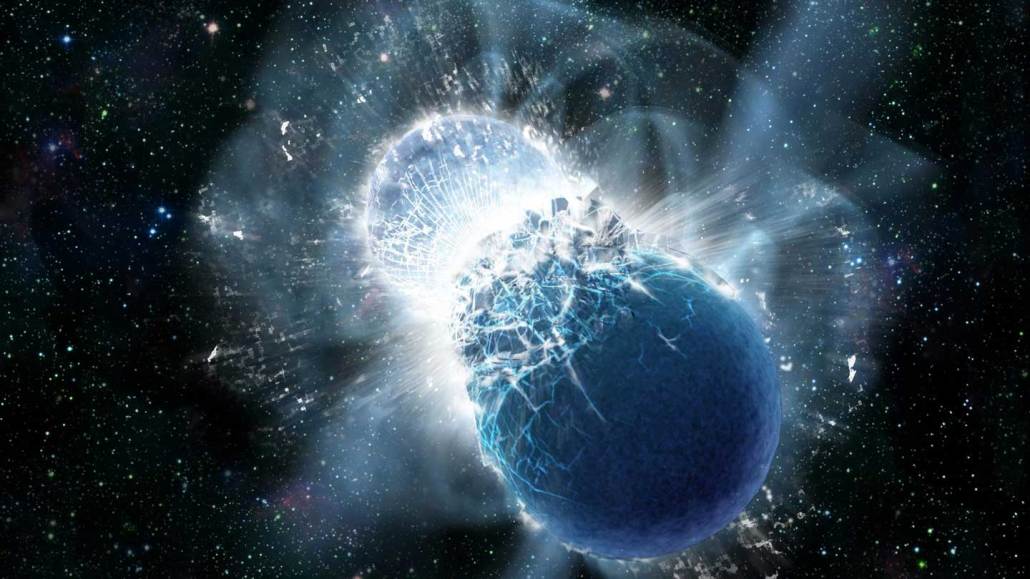
A pair of merging neutron stars, like those shown in this artist’s illustration, could have both shaken spacetime and emitted a burst of bright radio waves. Astronomers thought this was possible, but hadn’t seen convincing evidence of it until now.
Dana Berry, Swift/NASA
- More than 2 years ago
A neutron star pileup may have emitted two different kinds of cosmic signals: ripples in spacetime known as gravitational waves and a brief blip of energy called a fast radio burst.
One of the three detectors that make up the gravitational wave observatory LIGO picked up a signal from a cosmic collision on April 25, 2019. About 2.5 hours later, a fast radio burst detector picked up a signal from the same region of sky, researchers report March 27 in Nature Astronomy.
If strengthened by further observations, the finding could bolster the theory that mysterious fast radio bursts have multiple origins — and neutron star mergers are one of them.
“We’re 99.5 percent sure” the two signals came from the same event, says astrophysicist Alexandra Moroianu, who spotted the merger and its aftermath while at the University of Western Australia in Perth. “We want to be 99.999 percent sure.”
Unfortunately, LIGO’s two other detectors didn’t catch the signal, so it’s impossible to precisely triangulate its location. “Even though it’s not a concrete, bang-on observation for something that’s been theorized for a decade, it’s the first evidence we’ve got,” Moroianu says. “If this is true … it’s going to be a big boom in fast radio burst science.”
Mysterious radio bursts
Astronomers have spotted more than 600 fast radio bursts, or FRBs, since 2007. Despite their frequency, the causes remain a mystery. One leading candidate is a highly magnetized neutron star called a magnetar, which could be left behind after a massive star explodes (SN: 6/4/20). But some FRBs appear to repeat, while others are apparent one-off events, suggesting that there’s more than one way to produce them (SN: 2/7/20).
Theorists have wondered if a collision between two neutron stars could spark a singular FRB, before the wreckage from the collision produces a black hole. Such a smashup should emit gravitational waves, too (SN: 10/16/17).
Moroianu and colleagues searched archived data from LIGO and the Canadian Hydrogen Intensity Mapping Experiment, or CHIME, a fast radio burst detector in British Columbia, to see if any of their signals lined up. The team found one candidate pairing: GW190425 and FRB20190425A.
Even though the gravitational wave was picked up only by the LIGO detector in Livingston, La., the team spotted other suggestive signs that the signals were related. The FRB and the gravitational waves came from the same distance, about 370 million light-years from Earth. The gravitational waves were from the only neutron star merger LIGO spotted in that observing run, and the FRB was particularly bright. There may even have been a burst of gamma rays at the same time, according to satellite data — another aftereffect of a neutron star merger.
“Everything points at this being a very interesting combination of signals,” Moroianu says. She says it’s like watching a crime drama on TV: “You have so much evidence that anyone watching the TV show would be like, ‘Oh, I think he did it.’ But it’s not enough to convince the court.”
Neutron star secrets
Despite the uncertainty, the finding has exciting implications, says astrophysicist Alessandra Corsi of Texas Tech University in Lubbock. One is the possibility that two neutron stars could merge into a single, extra-massive neutron star without immediately collapsing into a black hole. “There’s this fuzzy dividing line between what’s a neutron star and what’s a black hole,” says Corsi, who was not involved in the new work.
In 2013, astrophysicist Bing Zhang of the University of Nevada, Las Vegas suggested that a neutron star smashup could create an extra-massive neutron star that wobbles on the edge of stability for a few hours before collapsing into a black hole. In that case, the resulting FRB would be delayed — just like in the 2019 case.
The most massive neutron star yet observed is about 2.35 times the mass of the sun, but theorists think they could grow to be around three times the mass of the sun without collapsing (SN: 7/22/22). The neutron star that could have resulted from the collision in 2019 would have been 3.4 solar masses, Moroianu and colleagues calculate.
“Something like this, especially if it’s confirmed with more observations, it would definitely tell us something about how neutron matter behaves,” Corsi says. “The nice thing about this is we have hopes of testing this in the future.”
The next LIGO run is expected to start in May. Corsi is optimistic that more coincidences between gravitational waves and FRBs will show up, now that researchers know to look for them. “There should be a bright future ahead of us,” she says.







